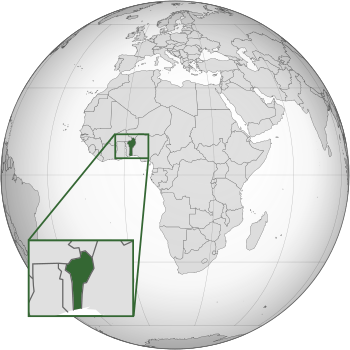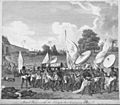Benin facts for kids
Quick facts for kids
Republic of Benin
République du Bénin (French)
|
|
|---|---|
|
Motto:
Fraternity, Justice, Labour
|
|

Location of Benin (dark green)
|
|
| Capital | Porto-Novo |
| Largest city | Cotonou |
| Official languages | French |
| National languages | |
| Ethnic groups
(2020)
|
|
| Religion
(2020)
|
|
| Demonym(s) |
|
| Government | Unitary presidential republic |
| Patrice Talon | |
| Mariam Chabi Talata | |
| Legislature | National Assembly |
| Independence
from France
|
|
|
• Republic of Dahomey established
|
11 December 1958 |
|
• Independence
|
1 August 1960 |
| Area | |
|
• Total
|
114,763 km2 (44,310 sq mi) (100th) |
|
• Water (%)
|
0.4% |
| Population | |
|
• 2022 estimate
|
13,754,688 (77th) |
|
• Density
|
94.8/km2 (245.5/sq mi) |
| GDP (PPP) | 2023 estimate |
|
• Total
|
|
|
• Per capita
|
|
| GDP (nominal) | 2023 estimate |
|
• Total
|
|
|
• Per capita
|
|
| Gini (2021) | ▼ 34.4 medium |
| HDI (2022) | low · 173rd |
| Currency | West African CFA franc (XOF) |
| Time zone | UTC+1 (WAT) |
| Date format | dd/mm/yyyy |
| Driving side | right |
| Calling code | +229 |
| ISO 3166 code | BJ |
| Internet TLD | .bj |
|
|
Benin (officially called the Republic of Benin) is a country in West Africa. Its capital city is Porto-Novo. However, the main center for government and the largest city is Cotonou. Most people in Benin live along the southern coast, near the Bight of Benin.
The official language of Benin is French. Other languages like Fon and Yoruba are also widely spoken. The main religions are Christianity (especially Roman Catholicism) and Islam. Some people also follow traditional faiths like Vodun.
Benin is part of many important international groups. These include the United Nations, the African Union, and the La Francophonie.
Contents
History of Benin
Before the 1600s, the area that is now Benin had many different groups of people and ways of governing. There were city-states along the coast, mainly made up of the Aja people, and also Yoruba and Gbe groups. Inland, there were tribal regions with Bariba, Mahi, and Kabye peoples. The Oyo Empire, located to the east, was a strong military power. It often raided the coastal kingdoms and tribal areas, making them pay tribute.
From the 1600s to the 1800s, the Kingdom of Dahomey ruled Benin. This area was known as the "Slave Coast" because many enslaved people were sent from here to the Americas. After slavery ended, France took control of the country and called it French Dahomey. In 1960, Dahomey became fully independent from France.
From 1972 to 1990, the country was called the People's Republic of Benin. It was a Marxist–Leninist state. The current Republic of Benin was formed in 1991.
Geography and Climate
Benin is a long, narrow country in West Africa. It stretches about 650 kilometers (400 miles) from the Niger River in the north to the Atlantic Ocean in the south. To its west is Togo, to the north are Burkina Faso and Niger, and to the east is Nigeria. The southern border is the Bight of Benin.
Benin has four main land areas from south to north:
- A low, sandy coastal plain, which is marshy and has lakes.
- Plateaus in southern Benin covered by Guinean forest-savanna mosaic, with altitudes between 20 and 200 meters (66 and 656 feet).
- A flatter area with rocky hills, reaching up to 400 meters (1,300 feet) around Nikki and Save.
- The Atacora mountain range in the northwest, which extends into Togo. The highest point is Mont Sokbaro, at 658 meters (2,159 feet).
Because much of Benin is low-lying and near the coast, it is vulnerable to climate change. Rising sea levels could affect people and the economy. Northern areas might also become more like deserts.
Benin has fields, mangroves, and some forests. In most of the country, you'll find savanna with thorny bushes and baobab trees. Some forests grow along riverbanks. In the north, the Reserve du W du Niger and Pendjari National Park are home to African bush elephants, lions, antelopes, hippopotamuses, and monkeys. These parks are important places for lions in West Africa. The African wild dog used to live here but is now thought to be extinct in Benin.
The coastal area gets about 1300 mm (51 inches) of rain each year. Benin has two rainy seasons (April to July, and September to November) and two dry seasons (December to April, and July to September). Temperatures are warmer and more humid along the coast. In Cotonou, the average high temperature is 31°C (88°F).
As you move north towards the Sahel, the temperatures change more. A dry wind called the Harmattan blows from December to March. During this time, the grass dries, plants turn reddish-brown, and fine dust fills the air, making the sky look cloudy.
Government and Economy
Benin is a presidential republic. This means the President of Benin is both the head of the country and the head of the government. People vote for their leaders in a multi-party system. The government has executive power, meaning it carries out laws. The National Assembly has legislative power, meaning it makes laws. The courts are separate from the government and the legislature. This system is based on the 1990 Constitution of Benin.
Benin's economy relies on farming for survival, growing cotton, and trade with nearby countries. Cotton is very important, making up 40% of the country's total economic output (GDP) and about 80% of its official exports.
People and Culture
Most of Benin's 13.7 million people live in the southern part of the country. The average life expectancy is 62 years. Benin is home to about 42 different African ethnic groups. Some of the largest groups include the Fon, Yoruba, Dendi, Bariba, and Fula. There are also people from other African countries like Nigeria and Togo, as well as Lebanese, Indian, and European communities.
Arts and Music
Beninese literature has a strong history of oral storytelling. Felix Couchoro wrote the first Beninese novel, L'Esclave, in 1929. Famous artists from Benin include singer Angélique Kidjo and actor Djimon Hounsou, both born in Cotonou. Composer Wally Badarou and singer Gnonnas Pedro are also from Benin.
Religion
The two main religions in Benin are Christianity and Islam. In 2020, about 52.2% of people were Christian, and 24.6% were Muslim. About 17.9% follow traditional faiths, including local animistic religions and Vodun. The town of Ouidah on the coast is a spiritual center for Beninese Vodun.
Education
The ability to read and write (literacy rate) in Benin is one of the lowest in the world. In elementary schools, local languages are used for teaching, and French is introduced later. In high school, French is the only language used for teaching.
Food
Beninese food often includes fresh meals with different sauces. In southern Benin, corn dough is a common food, served with peanut or tomato-based sauces. People eat fish, chicken, beef, goat, and sometimes bush rat. In northern Benin, yams are a main food, also served with sauces. People in the north also eat beef and pork fried in palm or peanut oil, or cooked in sauces. Cheese is used in some dishes. Other foods include couscous, rice, beans, and fruits like mangoes, oranges, and pineapples.
Meals usually have less meat and more vegetable fat. Smoked fish is common. Corn flour is made into dough using grinders. "Chicken on the spit" is a popular dish where chicken is roasted over a fire. Some people use outdoor mud stoves for cooking.
Sports
The most popular sports in Benin are association football (soccer), basketball, golf, cycling, baseball, softball, tennis, and rugby union. In recent years, baseball and teqball have also become popular.
Departments
Benin is divided into 12 main areas called Departments. These Departments are then split into 77 smaller areas called communes.
Images for kids
-
The Portuguese Empire was the longest European presence in Benin, from 1680 to 1961.
-
Yayi Boni's 2006 presidential inauguration.
-
The Pendjari National Park is a reserve for the West African lion and other large animals.
-
The Palais Des Congres in Cotonou.
-
Acarajé is a popular deep-fried dish made from black-eyed peas.
See also
 In Spanish: Benín para niños
In Spanish: Benín para niños

















